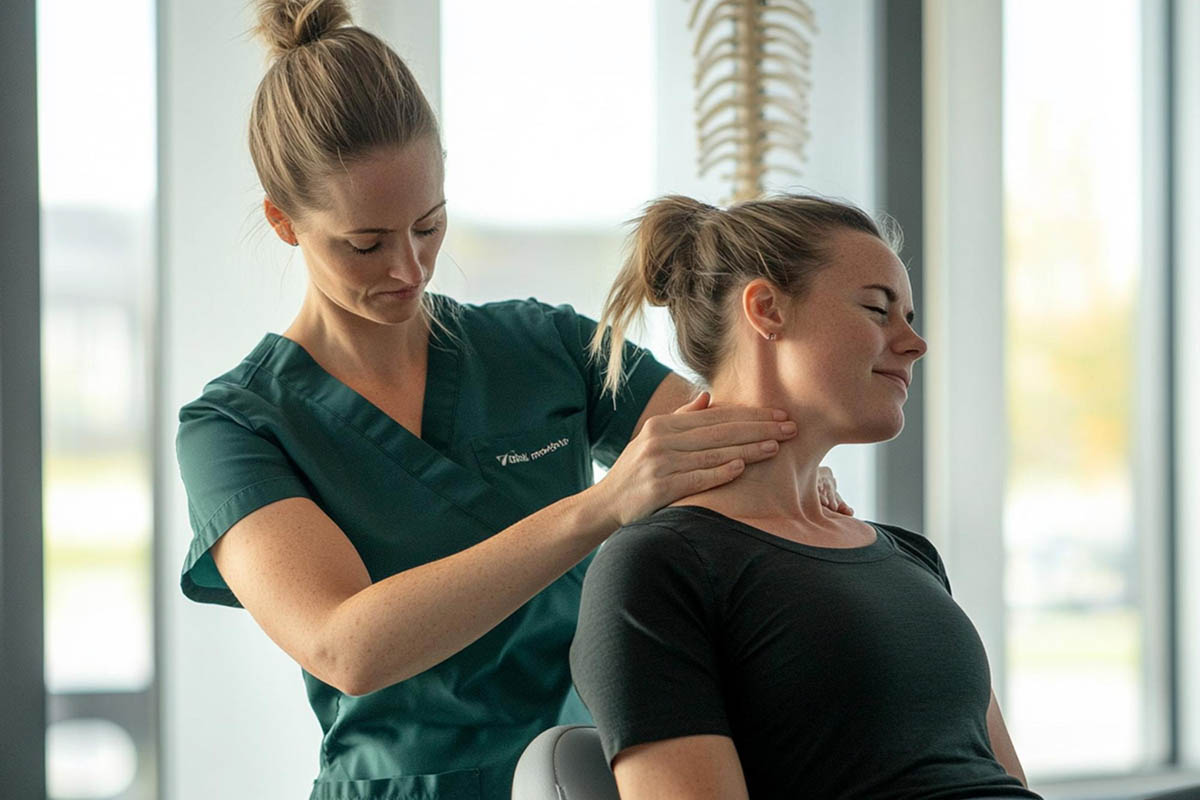
Neck pain is a common symptom experienced by millions of people worldwide, often impacting daily activities and overall quality of life. While pain relievers and muscle relaxers can offer temporary relief, they do not address the root causes of neck discomfort. For sustainable and long-term pain relief, physical therapy for neck pain offers an evidence-based solution. By focusing on strengthening the muscles, improving posture, and restoring movement patterns, physical therapy can help you regain control over your life. Let’s explore how you can use physical therapy to alleviate neck pain and prevent future episodes.
What Causes Neck Pain?
Neck pain, or musculoskeletal pain, can stem from various factors. One of the most common causes is poor posture, especially when slouching or sitting for prolonged periods, which places undue stress on the cervical spine. Research shows that around 50%of the population will deal with neck pain at least once during their lifetime, making it a widespread issue. Other causes include injuries such as a sports injury or neck strain, which can lead to inflamed soft tissues like muscles and ligaments. Conditions such as arthritis, spinal cord compression, or nerve root irritation can also result in chronic neck pain.
People with neck pain often report associated symptoms such as shoulder pain, blurred vision, headaches, and pain radiating down the arms. Understanding the underlying cause of your spinal pain is crucial for developing a treatment plan that brings long-term relief.
How Is It Diagnosed?
A proper diagnosis is the first step in managing neck pain effectively. Your healthcare provider will assess your condition by examining your neck’s range of motion, muscle strength, and reflexes. On average, people experiencing neck pain visit healthcare providers 3 to 17.2 times per year, with physical therapists being the most frequently consulted professionals. In some cases, imaging tests like X-rays or MRIs may be used to detect nerve root compression, issues in the thoracic spine, or damage to the spinal cord.
Once the underlying issue is diagnosed, a personalized physical therapy program can be created to address your specific needs. The goal is to restore normal joint function, improve muscle strength, and reduce pain symptoms.
Physical Therapy Treatment Methods
Physical therapy for neck pain employs a combination of conservative treatments and therapeutic techniques that target the root causes of the discomfort. Treatment methods are typically divided into passive and active physical therapy.
Passive Physical Therapy
During the initial stages of recovery, passive physical therapy plays a crucial role in reducing pain symptoms and inflammation. Techniques such as applying an ice pack or heating pad to the neck can help soothe sore muscles. Therapists may also use electrical nerve stimulation to block pain signals from reaching the brain, leading to a reduction in pain sensitivity.
Other methods include manual therapies like joint mobilization and massage, which target soft tissues around the neck and shoulders to improve flexibility and reduce muscle tension. These approaches aim to promote safe movement without increasing the risk of making the condition worse.
Active Physical Therapy
Once the initial severe pain has subsided, active physical therapy focuses on improving strength and flexibility. Therapeutic exercises and physical exercises that engage the core muscles, neck, and shoulder blades are introduced to help restore healthy movement patterns.
This phase of treatment also includes stretching exercises to improve flexibility and neck exercises to strengthen the muscles around the cervical spine. The goal is to promote better posture and reduce the risk of future neck pain episodes by ensuring proper alignment of the spine during physical activity.
Goals of Physical Therapy for Neck Pain
Every physical therapy program is tailored to the individual’s specific condition, but there are several common goals in treating neck pain:
- Reduce pain and stiffness: Techniques like electrical nerve stimulation or using a heating pad help alleviate immediate discomfort, allowing you to resume your daily activities without restriction.
- Improve head and neck range of motion: Restoring movement in the cervical spine is essential for returning to normal everyday activities. Therapists focus on exercises that improve flexibility and motion in the neck.
- Develop dynamic strengthening of the neck and its supporting musculature: Strengthening the muscles that support the neck, such as the upper back and core muscles, helps maintain a healthy position and prevents further injury.
- Develop strategies to prevent pain from recurring: By teaching correct posture and alignment, your therapist will help you maintain your neck healthy and avoid future episodes of pain.
When Physical Therapy May Be Recommended

Physical therapy is recommended for a wide range of neck-related conditions. Whether you’re dealing with unspecified chronic pain, recovering from a sports injury, or healing after surgery, physical therapy can be an effective treatment option. Here’s when it might be recommended:
- Unspecified chronic pain: If you’ve been dealing with neck pain for an extended period without a clear diagnosis, physical therapy can help by addressing underlying issues like poor posture or muscle weakness.
- Recovering from injury: Whether it’s a neck strain or a more severe injury, therapy can help restore joint function and improve physical function.
- Recovering from surgery: After surgical procedures involving the spine, physical therapy is critical for improving mobility and rebuilding strength.
Common Physical Therapy Exercises for Neck Pain
A crucial part of physical therapy for neck pain is engaging in exercises that promote healing and prevent future injury. Here are some common exercises that your therapist might incorporate into your exercise regimen:
Neck Rotation
This exercise helps increase neck flexibility and mobility. Starting from a steady position, slowly rotate your head from side to side, holding each position for a few seconds.
Chin Tucks
A powerful exercise for improving proper posture, chin tucks help align the head with the spine. You’ll start in a neutral position, gently tucking your chin toward your chest without moving your back or shoulders.
Shoulder Rolls
This simple exercise targets the muscles in the upper back and shoulder blades. Rolling your shoulders backward and forward helps release tension and restore movement.
Shoulder Shrugs
Shrugging your shoulders can relieve stiffness and tension in the neck. It also strengthens the muscles surrounding the cervical spine, providing more support.
Dumbbell Rows
Using light dumbbells, rows help build strength in the upper back and shoulders, which is vital for maintaining correct posture and supporting the neck.
Wall Angels
Standing against a wall with your arms at a 90-degree angle, move your arms upward and downward as though you’re making a snow angel. This exercise stretches the back and shoulders, encouraging better posture and alleviating neck tension.
Tips to Relieve Your Neck Pain
Incorporating a few simple habits into your daily routine can complement your physical therapy neck pain exercises and help maintain a neck healthy state.
Look All Around the Room
This simple tip can prevent stiffness by encouraging regular neck movement. Throughout the day, take time to gently rotate your head to both sides.
Move a Little Every Hour
If you have a desk job or spend long hours sitting, get up and move around every hour to prevent stiffness and promote healthy blood circulation in your neck.
Do the Chin Tuck
Regularly practice chin tucks to reinforce proper posture and keep your neck in a healthy position.
Improve Your Form at the Gym
Be mindful of your form during workouts. Poor technique can strain your neck and exacerbate your pain, so make sure to engage in safe movement while exercising.
Take a Child’s Pose
This yoga position stretches the back and neck, helping to alleviate tension in the spinal cord and soft tissues. Regular stretching can play a crucial role in keeping your neck healthy.
Is Physical Therapy Worth It for Neck Pain?
Physical therapy for neck pain has a profound impact on many people, offering them an improved quality of life and relief from pain symptoms. Globally, up to 70% of individuals will experience neck pain at least once, and 50-85% of these cases may develop into chronic conditions within five years. By addressing the root causes of pain and focusing on strengthening the muscles, physical therapy offers a long-term solution to chronic disease and recurring neck strain.
The Licensed Physical Therapists at Scottsdale Are Here for Your Neck Physical Therapy Needs

At Scottsdale, we offer the best physical therapy for neck pain near me, ensuring that you receive top-notch care tailored to your unique needs. Our team is dedicated to helping you regain your mobility and resume your daily activities pain-free. Whether you’re dealing with nonspecific neck pain or recovering from a sports injury, we’re here to guide you every step of the way.
Conclusion
Physical therapy for neck pain offers an effective and sustainable way to manage and alleviate discomfort. Through therapeutic exercises, proper diagnosis, and a commitment to consistent practice, you can achieve a significant reduction in pain and prevent future episodes.
At Scottsdale Physical Therapy & Performance, we specialize in treating neck pain through customized therapy programs designed to address the root causes and treatments of your discomfort. Our licensed physical therapists use a combination of cutting-edge techniques and personalized care to help you achieve lasting relief. Whether you’re dealing with chronic pain, recovering from an injury, or experiencing discomfort from poor posture, we are here to help you restore mobility and improve your quality of life. Request an appointment today to start your journey toward a pain-free neck.
How soon can I expect results from physical therapy for neck pain?
Depending on the severity of your condition, you might start to feel improvements within a few weeks. However, consistent effort over time delivers the best results.
Can physical therapy completely eliminate chronic neck pain?
While it may not eliminate the condition entirely in some cases, physical therapy significantly improves physical function and reduces pain symptoms. Many people experience long-term relief.
Are there any exercises I should avoid if I have neck pain?
Yes, avoid exercises that strain the neck excessively, such as high-impact activities or those requiring you to hold your neck in a steady position for long periods. Your care team will help guide you on what to avoid.









